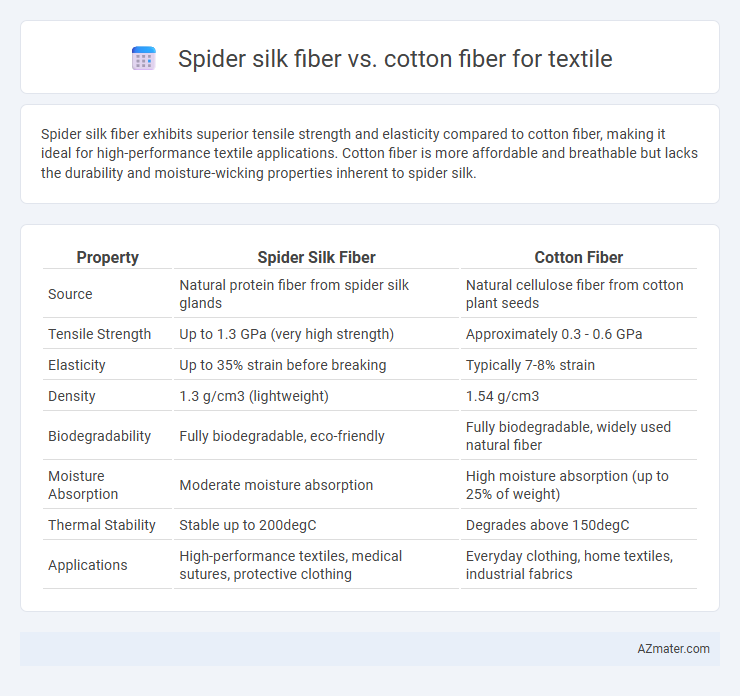Spider silk fiber exhibits superior tensile strength and elasticity compared to cotton fiber, making it ideal for high-performance textile applications. Cotton fiber is more affordable and breathable but lacks the durability and moisture-wicking properties inherent to spider silk.
Table of Comparison
| Property | Spider Silk Fiber | Cotton Fiber |
|---|---|---|
| Source | Natural protein fiber from spider silk glands | Natural cellulose fiber from cotton plant seeds |
| Tensile Strength | Up to 1.3 GPa (very high strength) | Approximately 0.3 - 0.6 GPa |
| Elasticity | Up to 35% strain before breaking | Typically 7-8% strain |
| Density | 1.3 g/cm3 (lightweight) | 1.54 g/cm3 |
| Biodegradability | Fully biodegradable, eco-friendly | Fully biodegradable, widely used natural fiber |
| Moisture Absorption | Moderate moisture absorption | High moisture absorption (up to 25% of weight) |
| Thermal Stability | Stable up to 200degC | Degrades above 150degC |
| Applications | High-performance textiles, medical sutures, protective clothing | Everyday clothing, home textiles, industrial fabrics |
Introduction to Spider Silk and Cotton Fibers
Spider silk fiber, renowned for its exceptional tensile strength and elasticity, offers promising applications in advanced textile manufacturing due to its lightweight and biodegradable properties. Cotton fiber, a staple in the textile industry, is prized for its natural softness, breathability, and moisture absorption, making it ideal for everyday comfort and versatility. Comparing these fibers highlights spider silk's superior durability and sustainability advantages alongside cotton's widespread availability and cost-effectiveness.
Structural Composition Comparison
Spider silk fiber exhibits a highly organized hierarchical protein structure composed primarily of repetitive amino acid sequences, such as glycine and alanine, forming beta-sheet nanocrystals that provide exceptional tensile strength and elasticity. Cotton fiber consists mainly of cellulose, a polysaccharide composed of long chains of glucose units arranged in crystalline and amorphous regions, contributing to its softness and moisture absorption but lower strength compared to spider silk. The molecular arrangement in spider silk facilitates superior mechanical properties ideal for advanced textiles, while cotton's cellulose structure offers natural breathability and comfort for everyday fabric use.
Mechanical Strength and Durability
Spider silk fiber exhibits superior mechanical strength compared to cotton fiber, featuring tensile strength ranging from 1.0 to 2.0 GPa, which significantly exceeds cotton's average tensile strength of approximately 0.3 to 0.6 GPa. The elasticity of spider silk, capable of stretching up to 30%, enhances its durability and resistance to wear, whereas cotton fibers tend to degrade faster under repeated stress and environmental exposure. These properties make spider silk fiber a highly durable and robust alternative for advanced textile applications requiring enhanced performance and longevity.
Elasticity and Flexibility Differences
Spider silk fiber exhibits exceptional elasticity, stretching up to five times its original length without breaking, surpassing cotton fiber's limited stretch capacity of approximately 8-10%. Its molecular structure, composed of repetitive protein sequences, provides superior flexibility, allowing spider silk to bend and adapt under stress without losing strength, unlike the more rigid cellulose chains in cotton fibers. This combination of high elasticity and flexibility makes spider silk a highly durable and resilient material for advanced textile applications.
Moisture Absorption and Comfort
Spider silk fiber exhibits superior moisture absorption compared to cotton fiber, with its hygroscopic nature allowing it to retain moisture without feeling damp, enhancing wearer comfort in various climates. The protein-based structure of spider silk facilitates excellent breathability and thermal regulation, making it more effective than cotton in maintaining skin dryness and reducing sweat accumulation. Textiles made from spider silk fibers provide a lightweight, smooth texture with enhanced elasticity, contributing to a comfortable fit and improved moisture management over traditional cotton fabrics.
Biodegradability and Environmental Impact
Spider silk fiber exhibits superior biodegradability compared to cotton fiber, breaking down naturally without releasing harmful residues. Produced through bioengineered processes, spider silk reduces reliance on water-intensive cotton farming, lowering environmental impact significantly. The sustainable production and decomposition of spider silk contribute to a decreased carbon footprint and minimized soil and water pollution in textile manufacturing.
Production Methods and Scalability
Spider silk fiber production relies on bioengineering techniques such as recombinant DNA technology to mass-produce silk proteins in host organisms like bacteria, yeast, or plants, enabling sustainable and scalable synthesis compared to limited natural spider silk harvesting. Cotton fiber production involves large-scale agricultural cultivation requiring significant land, water, and pesticide inputs, impacting environmental sustainability and scalability due to dependency on climatic conditions. The biotechnological scalability of spider silk offers potential for consistent high-performance textile applications, while cotton remains dominant due to established infrastructure despite environmental challenges.
Applications in the Textile Industry
Spider silk fiber exhibits exceptional tensile strength, elasticity, and biodegradability, making it ideal for high-performance textile applications such as protective clothing, medical sutures, and luxury fabrics. Cotton fiber remains widely used due to its softness, breathability, and ease of dyeing, primarily in casual wear, home textiles, and mass-market apparel. Emerging research combines spider silk protein with cotton to create hybrid textiles that enhance durability and comfort for innovative fashion and specialized industrial textiles.
Cost Analysis and Market Viability
Spider silk fiber offers exceptional strength-to-weight ratio and biodegradability, but its high production costs and complex manufacturing processes limit large-scale textile applications compared to cotton fiber. Cotton remains dominant due to its affordability, established supply chains, and scalability despite lower tensile strength and durability. Market viability favors cotton for mass production textiles, while spider silk targets niche markets demanding premium, sustainable materials with willingness to pay higher prices.
Future Prospects and Innovations
Spider silk fiber demonstrates exceptional tensile strength, biodegradability, and elasticity compared to traditional cotton fiber, positioning it as a transformative material for future textile innovations. Advances in bioengineering and synthetic biology are enabling scalable production of spider silk proteins, promising eco-friendly fabrics with superior performance for athletic wear, medical textiles, and high-tech applications. Continued research into nanoparticle integration and hybrid composites is expected to enhance the thermal regulation, durability, and moisture-wicking properties of spider silk-based textiles, surpassing conventional cotton fiber capabilities.

Infographic: Spider silk fiber vs Cotton fiber for Textile
 azmater.com
azmater.com